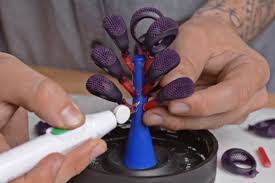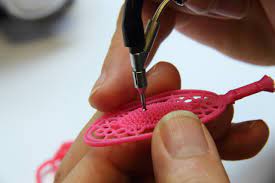Assayer and Hallmark Administrator
SECTOR: GEMS & JEWELLERY
SUB-SECTOR: Handmade Gold and Gems-Set Jewellery
OCCUPATION: Metal Alloying
REFERENCE ID: G&J/Q0402
ALIGNED TO: NCO-2004/ 7313.18
Assayer and Hallmark Administrator: The Assayer tests the precious-metal alloy
or jewellery and analyses it to determine the proportion of gold or purity of gold.
Based on the assaying results, the hallmark is assigned to indicate its level of
purity.
Brief Job Description: This individual at work tests the gold alloy metal or
jewellery through various assaying processes and stamps the hallmark. Assaying
involves multiple stages of assessment to determine the proportion of gold in the
alloy. After performing the assaying process and analyzing the results, the
precious metal or jewellery is marked with internationally defined symbols and
characters for hallmarking.
Personal Attributes: The job requires the individual to have: integrity; attention
to details; good eyesight; steady hands; ability to work in a process driven team
and comply with standards. The individual must also be able to use reflective skills
in order to avoid errors and hazards when dealing with sharp tools, machines of
high temperature and chemicals
Unit Code G&J/N0402
Unit Title
(Task) Assay and administer hallmark the gold alloy product
Description This OS unit is about testing the gold metal alloy or gold jewellery to determine the
proportion of gold in the product and hallmarking it with international standards of
precious metal purity
Scope This unit/ task covers the following:
Perform preliminary assay process
Perform assaying through touchstone process
Prepare metal or jewellery for fire assay process and perform fire assay
Hallmark the product
Performance Criteria(PC) w.r.t. the Scope
Element Performance Criteria
Preliminary assaying To be competent, the user/individual on the job must be able to:
PC1. receive precious-metal products for assaying
PC2. use X-ray fluorescence (XRF) machine to test the product
PC3. keep the product at various indicator points in the machine to test the
composition of gold
PC4. record the findings which are displayed in the screen / monitor
PC5. find the composition of gold using XRF machine
PC6. place the gold metal or jewellery in appropriate points and confirm the results
PC7. record the findings in the specified format
Touchstone assaying To be competent, the user/individual on the job must be able to:
PC8. receive goods or products for assaying
PC9. rub the gold metal or jewellery onto a touchstone
PC10. rub the gold needle of known Karatage on the side for visual comparison
PC11. use the standard acids such as Nitric acid for testing and apply on both the
rubbings using a dropper
PC12. compare the colour of the rubbing of metal and test needle after acid
application
PC13. analyse the findings and record them
PC14. find the composition of gold in the metal or jewellery using touchstone process
PC15. use effectively the tools for touchstone method such as touchstone, test
needle, test acids
PC16. visually compare and identify the results of the testing process
Fire assaying To be competent, the user/individual on the job must be able to:
PC17. select the gold products or cut pieces through standard sampling process
according to Bureau of Indian Standards (BIS) norms
PC18. melt the sample using furnace
PC19. weigh the melted metal accurately using a digital weighing scale which is
connected to a computer
PC20. add some silver to gold pieces and cover them using lead foil such that it looks
like a ball kind of structure
PC21. perform cupellation process by putting the lead foil containing silver and gold
pieces into cupel and heating them at around 1100 degrees centigrade
PC22. collect the gold, silver and any insoluble metals such as Rhodium, Iridium, etc.
PC23. stamp the metal to make it flat
PC24. anneal the metal and draw it to a roll form
PC25. dip the rolled metal in nitric acid to remove the silver content (this is called
parting stage)
PC26. wash and dry the metal left out
PC27. weigh the metal and compare the weight with before assay process to
determine the composition of gold in the metal
PC28. comply with the standards and perform the process accurately
PC29. accurately weigh the product and record them at each stage of process
PC30. operate equipments for cupellation process and set parameters appropriately
such as temperature as per specification
PC31. identify and handle different types of acids appropriately
PC32. record the findings at each stage for tracking
PC33. ensure that there is no mix up of different products during assaying process
PC34. determine the composition (Karatage) of gold in the alloy after fire assay
process by weighing them
Compliance to
standards
To be competent, the user/individual on the job must be able to:
PC35. perform all the necessary steps and tests in the assaying process to determine
the gold Karatage
PC36. execute the work in each stage as per the quality standards
Hallmarking To be competent, the user/individual on the job must be able to:
PC37. understand the result of the assaying process and hallmark sign to be printed
PC38. use computer system and software such as CAD/CAM to enable laser printing
PC39. set the size of print as per the size of jewel
PC40. print the hallmark, which must consists of BIS logo, the fineness mark, mark of
assaying and hallmarking centre and year of mark
PC41. ensure that appropriate fineness mark is printed as per the assaying result
PC42. print the gold metal or jewellery with appropriate hallmark sign using laser
printing machine or any other equipment
PC43. ensure that all the contents are printed as per BIS standard
PC44. ensure that the fineness mark is printed according to the assaying process’
result
Knowledge and Understanding (K)
A. Organizational
Context
(Knowledge of the
company /
organization and
its processes)
The individual on the job needs to know and understand:
KA1. company’s policies on: acceptable limits of precious metal loss per product
type, delivery timelines, safety and hazards, security, IPR, and personnel
management
KA2. importance of the individual’s role in the workflow
KA3. reporting structure
KA4. documentation procedure followed in the organisation
KA5. quality standards followed by the company
KA6. typical customer profile and market trends
B. Technical
Knowledge
The individual on the job needs to know and understand:
KB1. different types of assaying process such as using XRF machine, touchstone
method and fire assay process
KB2. different types of hallmarks for different Karatages
KB3. properties of various metals involved in gold jewellery and testing processes
such as silver, iridium, etc.
KB4. chemicals used in testing process and their properties
KB5. operation of different equipment used in the assaying process such as XRF
machine, cupellation process machine.
KB6. compliance requirement in each stage of assaying process
KB7. parameters to be considered for finding the Karatage of gold in the product
KB8. touchstone usage, scraping technique and visual comparison of the rubbings
to find Karatage
KB9. contents of the hallmark sign and their purpose
KB10. to use computer system for recording of finding and documenting them
KB11. potential work hazards while using high temperature machines and chemicals
KB12. safety precautionary measures while handling hot metals and hazardous
chemicals
Skills (S) [Optional]
A. Core Skills/
Generic Skills
Basic reading and writing skills
The user/individual on the job needs to know and understand how:
SA1. to read documents and records relating to gold product
SA2. to record the weight and findings during assay process
Calculation skills
The user/individual on the job needs to know and understand how:
SA3. to accurately record the weight of gold metal or jewellery in each steps of
assaying as per standards
SA4. to calculate the composition of gold (Karatage) after completion of assay
process using the weight
Teamwork and some multitasking
The user/individual on the job needs to know and understand how:
SA5. to share work load as required
SA6. to deliver metal or jewellery to next work process on time
B. Professional Skills Reading notes
The user/individual on the job needs to know and understand:
SB1. how to read notes on the gold metal or jewellery and use equipments and
testing materials accordingly
SB2. How to read notes on gold jewellery regarding Karatage and use correct test
needle for rubbing process in touchstone method
Using tools, machines and materials
The user/individual on the job needs to know and understand how
SB3. to use the XRF machine
SB4. to use the equipments and materials used in touchstone method
SB5. to use equipment in cupellation process and usage of appropriate chemicals in
parting process
SB6. to understand safety procedures and hazards involved in handling machines
and chemicals
Hallmarking
The user/individual on the job needs to know and understand:
SB7. how and where to print the hallmark symbol in the gold metal or jewellery
SB8. the contents of a hallmark symbol and their purpose
Compliance to quality standards
The user/individual on the job needs to know and understand:
SB9. the necessary steps to be followed in each stage of assaying process
SB10. the organisational requirement in following the quality standards in the
process
Critical thinking
The user/individual on the job needs to know and understand how:
SB11. to spot process disruptions and delays
Unit Code G&J/N9910
Unit Title
(Task) Respect IPR of company as well as competitors
Description This OS unit is about maintaining company’s IPR and avoiding infringement on
copyright of others
Scope This unit/task covers the following:
Protect company’s Intellectual Property Rights (IPR)
Avoid infringement to copyright of other companies
Performance Criteria(PC) w.r.t. the Scope
Element Performance Criteria
Respecting IPR To be competent, the user/individual on the job must be able to:
PC1. prevent leak of new designs to competitors by reporting on time
PC2. spot any infringement of company’s product or design patents
PC3. report IPR violations observed in the market, to supervisor or company heads
PC4. read copyright clause of the material published on the internet and any other
printed material
PC5. consult supervisor or senior management when in doubt about using publicly
available information
PC6. report any infringement observed in the company
PC7. spot plagiarism and report
PC8. understand rationale of patents and IPR
PC9. avoid being involved in IPR violations
Knowledge and Understanding (K)
A. Organizational
Context
The individual on the job needs to know and understand:
KA1. company’s policies on IPR, plagiarism and order leaks
KA2. company’s patented products
KA3. market trends and company’s unique product range
KA4. reporting structure
B. Technical
Knowledge
The individual on the job needs to know and understand:
KB1. basics of patents and IPR laws
KB2. how IPR protection is important for competitiveness of a company
Skills (S) [Optional]
A. Core Skills/
Generic Skills
Communication skills
The user/individual on the job needs to know and understand how:
SA1. to effectively communicate any observed IPR violations or design leaks
B. Professional Skills Decision making
The user/individual on the job needs to know and understand when and how:
SB1. to report sources of IPR violations
Reflective thinking
The user/individual on the job needs to know and understand how:
SB2. to learn from past mistakes and report IPR violations on time
Critical thinking
The user/individual on the job needs to know and understand how:
SB3. to spot signs of violations and alert authorities in time
Unit Code G&J/N9912
Unit Title
(Task) Interact with colleagues and seniors
Description This OS unit is about communicating with colleagues and seniors in order to maintain
smooth ad hazards free work flow
Scope This unit/task covers the following:
Interact with supervisor
Interact with colleagues within and outside the department
Performance Criteria(PC) w.r.t. the Scope
Element Performance Criteria
Interaction with
supervisor
To be competent, the user/individual on the job must be able to:
PC1. receive and understand work instructions from reporting superior
PC2. communicate to reporting supervisor about process flow improvements,
product defects received from previous process, repairs and maintenance of
tools and machinery as required
PC3. communicate any potential hazards or expected process disruptions
PC4. handover completed work to supervisor
PC5. understand the work output requirements
PC6. comply with company policy and rule
PC7. deliver quality work on time as required by reporting any anticipated reasons
for delays
Interactions with
colleagues and other
departments
To be competent, the user/individual on the job must be able to:
PC8. work as a team with colleagues and share work as per their or own work load
and skills
PC9. work with colleagues of other departments such as frame making or
component making or polishing or setting or stores
PC10. communicate an discuss work flow related difficulties in order to find solutions
with mutual agreement
PC11. receive feedback from QC and rework in order to complete work on time
PC12. put team over individual goals
PC13. resolve conflicts and multi-task
Knowledge and Understanding (K)
A. Organizational
Context
(Knowledge of the
company /
organization and
its processes)
The individual on the job needs to know and understand:
KA1. company’s policies on personnel management
KA2. work flow involved in company’s jewellery manufacturing process
KA3. importance of the individual’s role in the workflow
KA4. reporting structure
B. Technical
Knowledge
The individual on the job needs to know and understand:
KB1. how to communicate effectively
KB2. how to build team coordination
Skills (S) [Optional]
A. Core Skills/
Generic Skills
Teamwork and some multitasking
The individual on the job needs to know and understand how:
SA1. to share work load as required
SA2. to deliver product to next work process on time
B. Professional Skills Decision making
The individual on the job needs to know and understand:
SB1. how to report potential areas of disruptions to work process
SB2. when to report to supervisor and when to deal with a colleague depending on
the type of concern
Reflective thinking
The individual on the job needs to know and understand:
SB5. how to improve work process
Critical thinking
The individual on the job needs to know and understand:
SB6. how to spot process disruptions and delays
Unit Code G&J/N9914
Unit Title
(Task) Work towards having a safe work environment
Description This OS unit is about being aware of and communicating potential hazards and
dangers of accidents on the job
Scope This unit/task covers the following:
Understand potential sources of accidents
Communicate to reporting supervisor about hazards in time
Performance Criteria(PC) w.r.t. the Scope
Element Performance Criteria
Understanding of
potential sources of
accidents and
communicating
To be competent, the user/individual on the job must be able to:
PC1. avoid accidents related to use of potentially dangerous chemicals, gas torches,
sharp tools and hazards from machines
PC2. suggest process flow improvements to reduce anticipated or repetitive hazards
PC3. report mishandling of tools, machines or hazardous materials
PC4. identify electrical problems that could result in accident
PC5. spot and report potential hazards on time
PC6. follow company policy and rules regarding hazardous materials
PC7. deliver quality work on time as required by reporting any anticipated reasons
for delays
Knowledge and Understanding (K)
A. Organizational
Context
(Knowledge of the
company /
organization and
its processes)
The individual on the job needs to know and understand:
KA1. company’s policies on handling: harmful chemicals and sharp tools, safety and
hazards of machines, fire safety and, disposal of harmful chemicals and
materials
KA2. work flow involved in company’s jewellery manufacturing process
KA3. importance of the individual’s role in the workflow
KA4. reporting structure
B. Technical
Knowledge
The individual on the job needs to know and understand:
KB1. how different chemicals react and what could be the danger from them
KB2. how to use machines and tools without causing bodily harm
KB3. fire safety education
KB4. disposal of hazardous chemicals, tools and materials by following prescribed
environmental norms or as per company policy
Skills (S) [Optional]
A. Core Skills/
Generic Skills
Communication skills
The individual on the job needs to know and understand how:
SA1. to effectively communicate the danger
B. Professional Skills Decision making
The individual on the job needs to know and understand:
SB1. importance of reporting potential sources of danger
SB2. appropriate actions to be taken in the event of an accident
SB3. process for disposing of hazardous materials, safely and following
environmental guidelines
Reflective thinking
The individual on the job needs to know and understand how:
SB4. to learn from past mistakes regarding use of hazardous machines or
chemicals or gas torches
Critical thinking
The individual on the job needs to know and understand:
SB5. how to spot danger
SB6. procedures to follow in the event of a fire or other hazard
Keywords /Terms Description
Sector Sector is a conglomeration of different business operations having similar
business and interests. It may also be defined as a distinct subset of the
economy whose components share similar characteristics and interests.
Sub-sector Sub-sector is derived from a further breakdown based on the
characteristics and interests of its components.
Occupation Occupation is a set of job roles, which perform similar/ related set of
functions in an industry.
Function Function is an activity necessary for achieving the key purpose of the
sector, occupation, or an area of work, which can be carried out by a
person or a group of persons. Functions are identified through functional
analysis and form the basis of OS.
Sub-function Sub-functions are sub-activities essential to fulfil the achieving the
objectives of the function.
Job role Job role defines a unique set of functions that together form a unique
employment opportunity in an organisation.
Occupational Standards
(OS)
OS specify the standards of performance an individual must achieve
when carrying out a function in the workplace, together with the
knowledge and understanding they need to meet that standard
consistently. Occupational Standards are applicable both in the Indian
and global contexts.
Performance Criteria Performance criteria are statements that together specify the standard of
performance required when carrying out a task.
National Occupational
Standards (OS)
NOS are occupational standards which apply uniquely in the Indian
context.
Qualifications Pack (QP) QP comprises the set of OS, together with the educational, training and
other criteria required to perform a job role. A QP is assigned a unique
qualifications pack code.
Unit Code Unit code is a unique identifier for an Occupational Standard, which is
denoted by an ‘N’
Unit Title Unit title gives a clear overall statement about what the incumbent
should be able to do.
Description Description gives a short summary of the unit content. This would be
helpful to anyone searching on a database to verify that this is the
appropriate OS they are looking for.
Scope Scope is a set of statements specifying the range of variables that an
individual may have to deal with in carrying out the function which have
a critical impact on quality of performance required.
Knowledge and
Understanding
Knowledge and understanding are statements which together specify the
technical, generic, professional and organisational specific knowledge
that an individual needs in order to perform to the required standard.
Organisational Context Organisational context includes the way the organisation is structured
and how it operates, including the extent of operative knowledge
managers have of their relevant areas of responsibility
Technical Knowledge Technical knowledge is the specific knowledge needed to accomplish
specific designated responsibilities.
Core Skills/ Generic
Skills
Core skills or generic skills are a group of skills that are the key to learning
and working in today’s world. These skills are typically needed in any
work environment in today’s world. These skills are typically needed in
any work environment. In the context of the OS, these include
communication related skills that are applicable to most job roles.
Keywords /Terms Description
IPR Intellectual Property Rights
NOS National Occupational Standard(s)
NVQF National Vocational Qualifications Framework
NSQF National Qualifications Framework
NVEQF National Vocational Education Qualifications Framework
QP Qualifications Pack
CRITERIA FOR ASSESSMENT OF TRAINEES
Job Role Assayer & Hallmarker
Qualification Pack Assayer & Hallmarker
Sector Skill Council GEMS & JEWELLERY
To pass the Assessment, a candidate needs to score 50% in Theory and 70% in Practical
Assessment Strategy Marks Allocation
NOS Elements Performance Criteria Theory Practical
- G&J/N0402 Assay and
Administer Hallmark on
the precious-metal
product
Preliminary assaying
PC1. find the composition of gold using XRF machine 1 8
PC2. place the gold metal or jewellery in appropriate points and
confirm the results 1 6
PC3. record the findings in the specified format 2 6
Touchstone assaying
PC4. find the composition of gold in the metal or jewellery using
touchstone process
0 6
PC5. use effectively the tools for touchstone method such as
touchstone, test needle, test acids 1 6
PC6. visually compare and identify the results of the testing
process
0 6
Fire assaying
PC7. comply with the standards and perform the process
accurately 1 6
PC8. accurately weigh the product and record them at each stage
of process 1 4
PC9. operate equipments for cupellation process and set
parameters appropriately such as temperature as per
specification
0 4
PC10. identify and handle different types of acids appropriately 1 4
PC11. record the findings at each stage for tracking 0 3
PC12. ensure that there is no mix up of different products during
assaying process 1 3
PC13. determine the composition (Karatage) of gold in the alloy
after fire assay process by weighing them 0 2
Compliance to standards
PC14. perform all the necessary steps and tests in the assaying
process to determine the gold Karatage 1 2
PC15. execute the work in each stage as per the quality standards 0 1
Hallmarking
PC16. print the gold metal or jewellery with appropriate hallmark
sign using laser printing machine or any other equipment 0 1
PC17. ensure that all the contents are printed as per BIS standard 0 1
PC18. ensure that the fineness mark is printed according to the 0 1
CRITERIA FOR ASSESSMENT OF TRAINEES
assaying process’ result
Sub Total 10 70
- G&J/N9910 Maintain IPR
and respect copyright
Respecting IPR
PC1. spot plagiarism and report 1 0
PC2. understand rationale of patents and IPR 1 0
PC3. avoid being involved in IPR violations 1 0
Sub Total 3 0 - G&J/N9912Coordinate
with others
Interaction with
supervisor
PC1. Understand the work output requirements 1 2
PC2. Understand company policy and rule 1 0
PC3. Deliver quality work on time as required by reporting any
anticipated reasons for delays 1 1
Interactions with
colleagues and other
departments
PC4. Put team over individual goals 1 1
PC5. Conflicts resolution and multi-tasking 0 1
Sub Total 4 5
4.G&J/N9914 Maintain
safe and clean work
environment
Understanding of potential sources of
accidents and communicating
PC1. Spot and report potential hazards on time 1 2
PC2. Follow company policy and rules regarding use of hazardous
materials 1 2
PC3. Deliver quality work on time as required by reporting any
anticipated reasons for delays 1 1
Sub Total 3 5
Total 20 80








